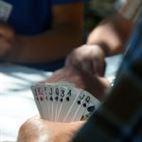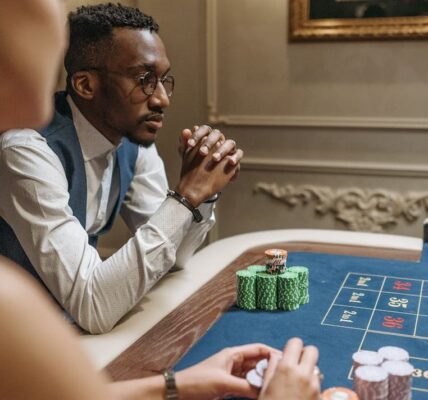“Beyond the Cards: The Psychology of Table Image and Manipulating Your Opponents” is a comprehensive guide that delves into the intriguing world of poker psychology. This guide explores the concept of table image and how it can be strategically manipulated to gain an advantage over opponents. By understanding the psychological factors at play during a poker game, players can enhance their decision-making skills and increase their chances of success at the table. Whether you are a beginner or an experienced player, this guide offers valuable insights into the psychological aspects of poker that can help you take your game to the next level.
The Impact of Table Image on Poker Psychology
Table image is a powerful tool that can be used to gain an advantage over your opponents. It is the impression you create through your actions, demeanor, and overall behavior at the poker table. A strong table image can intimidate opponents, making them more likely to fold or make mistakes. Conversely, a weak table image can make you an easy target, as opponents may be more inclined to bluff or take advantage of your perceived weaknesses.
The impact of table image on poker psychology cannot be overstated. When players sit down at a table, they begin to form opinions about each other based on their observations. These opinions can influence how players interact with each other and make decisions throughout the game. For example, if a player is perceived as tight and conservative, others may be more cautious when playing against them, fearing that they have a strong hand. On the other hand, if a player is seen as loose and aggressive, opponents may be more likely to call their bets, assuming they are bluffing.
Manipulating your table image is a skill that can be honed with practice. One way to do this is by carefully selecting the hands you play. By playing a tight range of hands, you can create the perception that you only play strong cards. This can make opponents more hesitant to call your bets, giving you an advantage when you do have a strong hand. Similarly, playing a wider range of hands can create the perception that you are loose and unpredictable, making opponents more likely to fold or make mistakes.
Another way to manipulate your table image is through your betting patterns. By varying the size of your bets and the timing of your raises, you can create confusion and uncertainty in the minds of your opponents. For example, if you consistently make large bets when you have a strong hand, opponents may become wary of calling your bets, fearing that they are walking into a trap. Conversely, if you occasionally make large bets when you have a weak hand, opponents may be more likely to call, assuming that you are bluffing.
Body language and demeanor also play a significant role in table image. The way you carry yourself at the table can convey confidence or weakness, which can influence how opponents perceive you. For example, maintaining a calm and composed demeanor can make opponents believe that you have a strong hand, even when you don’t. Similarly, displaying signs of nervousness or hesitation can make opponents more likely to call your bets, assuming that you are bluffing.
Understanding the Psychology of Manipulating Your Poker Opponents
Manipulating your table image involves intentionally presenting yourself in a way that misleads your opponents and influences their decision-making. This can be done through a variety of tactics, such as bluffing, acting, and strategic betting patterns. By understanding the psychology behind these tactics, you can effectively manipulate your opponents and increase your chances of winning.
Bluffing is perhaps the most well-known and widely used tactic in poker. It involves making a bet or raise with a weak hand in order to deceive your opponents into thinking you have a strong hand. The key to successful bluffing is convincing your opponents that you are confident and have a strong hand, even when you don’t. This requires a combination of acting skills, reading your opponents’ reactions, and understanding their table image.
Acting is another important aspect of manipulating your opponents. By consciously controlling your facial expressions, body language, and tone of voice, you can give off false tells and mislead your opponents. For example, if you have a strong hand, you might act nervous or hesitant to make your opponents believe that you are bluffing. Conversely, if you have a weak hand, you might act confident and relaxed to make your opponents think you have a strong hand.
Strategic betting patterns can also be used to manipulate your opponents’ decisions. By varying your bet sizes and timing, you can create confusion and uncertainty in your opponents’ minds. For example, if you consistently make small bets when you have a strong hand and large bets when you have a weak hand, your opponents may become unsure of your hand strength and make mistakes in their own betting decisions.
Understanding the psychology behind these tactics is crucial for successful manipulation. It requires observing your opponents’ behavior, analyzing their table image, and adapting your own strategy accordingly. For example, if you notice that a particular opponent is easily influenced by acting and bluffing, you can use these tactics more frequently against them. On the other hand, if you are playing against a more experienced player who is less likely to be swayed by acting, you may need to rely more on strategic betting patterns.
How Table Image Can Influence Your Poker Strategy
If you have a tight and conservative table image, other players are more likely to fold when you make a big bet or raise. They will assume that you only play strong hands and are unlikely to bluff. This can be advantageous as it allows you to win pots without having to show your cards. By maintaining a tight image, you can manipulate your opponents into folding even when you have a weaker hand.
On the other hand, if you have a loose and aggressive table image, other players may be more inclined to call or even re-raise your bets. They will assume that you are bluffing or playing with weaker hands. This can be beneficial as it allows you to extract more value from your strong hands. By capitalizing on your loose image, you can manipulate your opponents into making mistakes and losing more chips.
It is important to note that your table image is not fixed and can change throughout the course of a poker session. If you have been playing conservatively for a while, you can use that to your advantage by suddenly becoming more aggressive. This change in behavior can catch your opponents off guard and make them question your motives. Similarly, if you have been playing aggressively, you can switch to a more conservative style to confuse your opponents and throw them off their game.
To effectively manipulate your table image, it is crucial to pay attention to the reactions and behaviors of your opponents. Are they folding easily when you make big bets? Or are they calling and re-raising frequently? By observing their responses, you can adjust your playing style accordingly. If your opponents are folding too easily, you can increase your aggression. If they are calling too often, you can tighten up and only play premium hands.
Psychological Tactics for Manipulating Your Poker Opponents
One way to manipulate your opponents through table image is by portraying yourself as a tight player. A tight player is someone who plays conservatively, only entering pots with strong hands. By consistently folding mediocre hands and only playing premium ones, you can create the perception that you are a cautious and disciplined player. This can lead your opponents to believe that when you do enter a pot, you have a strong hand, causing them to fold more often or make mistakes when facing your bets.
On the other hand, portraying yourself as a loose player can also be an effective strategy. A loose player is someone who plays a wide range of hands, often entering pots with weaker holdings. By occasionally playing speculative hands and making bold bluffs, you can create the perception that you are an unpredictable and aggressive player. This can intimidate your opponents and make them more hesitant to challenge your bets, giving you more opportunities to steal pots.
Another psychological tactic for manipulating your opponents is the use of body language. Non-verbal cues such as facial expressions, posture, and gestures can reveal information about your hand strength or intentions. For example, a player who is bluffing may display signs of nervousness, such as fidgeting or avoiding eye contact. By observing and interpreting these cues, you can gain insights into your opponents’ hands and adjust your own strategy accordingly.
However, it is important to note that body language can be misleading, and skilled players may intentionally use it to deceive their opponents. This is known as “reverse tells,” where players purposefully display false cues to mislead their opponents. Therefore, it is crucial to consider multiple factors and not rely solely on body language when making decisions at the poker table.
In addition to table image and body language, understanding your opponents’ psychological tendencies can also give you an advantage. Some players are naturally more risk-averse, while others are more prone to taking risks. By identifying these tendencies, you can tailor your strategy to exploit their weaknesses. For example, if you are playing against a risk-averse player, you can make larger bets to pressure them into folding, knowing that they are more likely to avoid taking unnecessary risks.
The Role of Psychology in Developing a Winning Poker Strategy
Manipulating your opponents’ table image is a powerful tool in poker. By carefully crafting your own table image, you can influence the way your opponents perceive you and, in turn, manipulate their decisions. For example, if you have been playing conservatively for a while and suddenly start making big bets, your opponents may assume that you have a strong hand and fold, even if you are bluffing. Similarly, if you have been playing aggressively and suddenly start playing more cautiously, your opponents may think that you have a weak hand and call your bets, giving you the opportunity to win big.
To effectively manipulate your opponents’ table image, you must be aware of the image you are projecting and make strategic adjustments accordingly. This requires a deep understanding of human psychology and the ability to read your opponents’ reactions and body language. For example, if you notice that your opponents are becoming more cautious and folding more often when you make big bets, it may be a sign that they are starting to perceive you as a tight player. In this case, you can take advantage of their perception by bluffing more often and making larger bets to force them to fold.
Another important aspect of manipulating your opponents is the use of psychological tactics. For example, you can use reverse psychology to trick your opponents into making decisions that benefit you. By acting in a certain way or making certain statements, you can influence your opponents’ thought processes and lead them to make mistakes. However, it is important to use these tactics sparingly and strategically, as overusing them can make you predictable and easy to read.
In conclusion, the role of psychology in developing a winning poker strategy cannot be underestimated. Understanding the psychology of table image and learning how to manipulate your opponents can greatly enhance your chances of success. By carefully crafting your own table image and using psychological tactics, you can influence the decisions your opponents make and gain a significant advantage at the poker table. So, the next time you sit down to play a game of poker, remember that it is not just about the cards – it is about the mind games as well.










